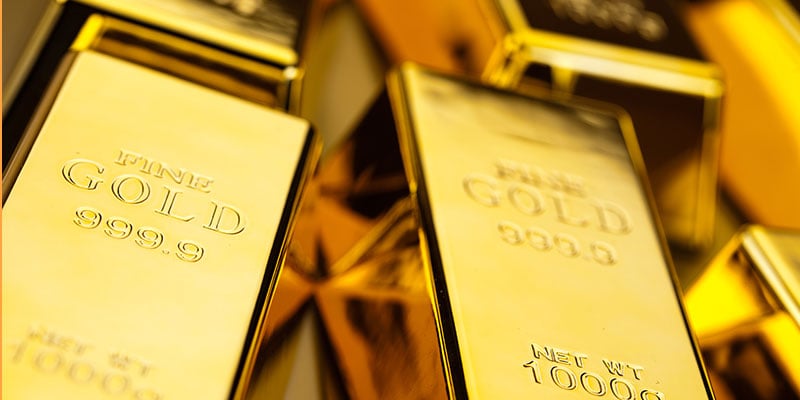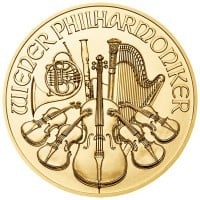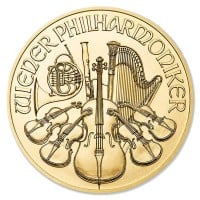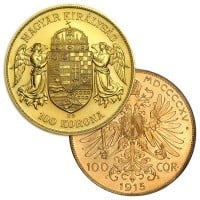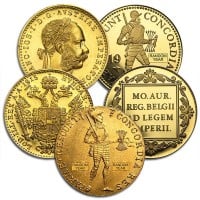Austrian Gold Coins
| Qty | Price Each |
|---|---|
| 1 - 9 | $2,434.85 |
| 10 - 19 | $2,427.85 |
| 20 - 49 | $2,420.85 |
| 50+ | Call for pricing |
| Full Tube Qty = 10 | |
|
|
|
| Qty | Price Each |
|---|---|
| 1 - 9 | $136.23 |
| 10 - 39 | $133.41 |
| 40 - 400 | $130.59 |
| 401+ | Call for pricing |
| Full Tube Qty = 20 | |
|
|
|
| Qty | Price Each |
|---|---|
| 1 - 9 | $2,437.75 |
| 10 - 19 | $2,415.17 |
| 20+ | Call for pricing |
|
|
|
| Qty | Price Each |
|---|---|
| 1 - 99 | $293.82 |
| 100+ | Call for pricing |
|
|
|
Investing in Austrian Gold Coins: A Guide to Precious Metal Investments
Austrian gold coins encompass a rich tapestry of numismatic treasures, celebrated for their historical legacy, captivating designs, and enduring worth. They provide historical insight into collectible world coins and sound money while remaining an invaluable addition to any coin-collecting portfolio.
Among the distinguished ensemble of Austrian coinage, the Austrian Philharmoniker, Austrian Corona, and Austrian Ducat stand out as iconic symbols of Austrian heritage and craftsmanship. Each of these is regularly offered by Money Metals Exchange.
The Austrian Philharmoniker
The Austrian Philharmoniker, affectionately known as the Vienna Philharmonic, made its debut in 1989 at the venerable Austrian Mint in Vienna. Adorning its obverse side are the majestic instruments of the renowned Vienna Philharmonic Orchestra, including the cello, violin, harp, flute, and horn, while the reverse side proudly showcases the Great Organ of the Golden Hall in Vienna's illustrious Musikverein concert hall. Available in a range of sizes, from 1 ounce to 1/10 ounce, the Austrian Philharmoniker's .9999 fine gold purity (99.99% pure) sets the standard for excellence in the global gold coin market.
The Austrian Ducat
The Austrian Ducat, also known as the Austrian Gold Ducat, has a rich history dating back to the Middle Ages. Originally introduced in the 13th century, the Ducat served as a widely circulated trade coin throughout the Holy Roman Empire and later the Austrian Empire. Adorned with intricate motifs and regal portraits on both obverse and reverse, the Ducat's 23.75 karat gold composition imparts a distinctive reddish hue, evoking a sense of timeless elegance. Though no longer circulating as legal tender currency, the Ducat remains a coveted treasure cherished by collectors for its historical resonance and masterful artistry.
The Austrian Corona
The Austrian Corona, also known as the Austrian 100 Corona Gold Coin, or simply a Korona, holds a significant place in Austrian numismatic history. First minted in 1908, the Austrian Corona was originally issued to commemorate the 60th anniversary of the reign of Emperor Franz Joseph I of Austria. Each gold Corona coin encapsulates a chapter of Austria's illustrious past, inviting collectors to embark on a journey through history with every gleaming specimen.
In summary, Austrian gold coins stand as beacons of numismatic excellence, revered by collectors and investors alike for their aesthetic allure, melt value, and profound historical significance. Whether one seeks the harmonious melodies of the Philharmoniker, the timeless elegance of the Ducat, or the cultural tapestry of the Corona, Austrian gold coins offer a timeless investment opportunity, weaving together the threads of Austria's rich heritage for generations to come.
The Austrian Gold Philharmoniker
The Gold Philharmoniker was first minted in 1989 to celebrate Austria's rich musical heritage and the renowned Vienna Philharmonic Orchestra. In The United States, it is common to refer to this coin as a gold Austrian Philharmonic.
Designs
Obverse (Front): The obverse side of the Gold Philharmoniker features a depiction of various musical instruments used by the Vienna Philharmonic Orchestra. These instruments include the cello, violin, harp, flute, and horn. The design symbolizes Austria's rich cultural heritage and its contribution to classical music. The words on this side include “WIENER PHILHARMONIKER.”
Reverse (Back): On the reverse side of the coin is an image of the Great Organ (pipe organ) of the Golden Hall in Vienna's Musikverein concert hall, where the Vienna Philharmonic Orchestra performs. This intricately designed image represents the orchestra's connection to Vienna and its iconic venues. The words included on this side are “REPUBLIK OSTERREICH,” “1 UNZE GOLD 999.9,” the year, and the face value “100 EURO.”
Specifications
Purity: The Gold Philharmoniker is struck in .9999 fine gold, making it one of the purest gold coins available on the market. This high level of purity ensures the coin's value and makes it a desirable investment for those seeking to own physical gold. These gold coins qualify for storage in a self-directed precious metals IRA.
Sizes: The Gold Philharmoniker is available in various sizes to cater to different investment preferences. These sizes include 1 ounce, 1/2 ounce, 1/4 ounce, and 1/10 ounce, providing flexibility for investors of all budgets.
Diameter and Thickness: The 1 ounce Gold Philharmoniker has a diameter of 37 millimeters and a thickness of 2 millimeters. The smaller denominations have proportional dimensions, allowing for easy identification and storage.
Legal Tender: The Gold Philharmoniker is legal tender in Austria, with face values denominated in euros. However, the coin's intrinsic value far exceeds its face value, primarily due to its high gold content and exquisite design.
The Gold Philharmoniker stands as a testament to Austria's rich cultural heritage and its contribution to the world of music and art. With its stunning design, exceptional purity, and enduring value, the Gold Philharmoniker remains a prized possession for collectors and investors alike. Whether purchased for its aesthetic appeal or as a hedge against economic uncertainty, the Gold Philharmoniker continues to captivate enthusiasts around the globe.
The Austrian Gold Ducat
The Austrian Ducat, also known as the Austrian Gold Ducat, has a rich history dating back to the Middle Ages. Originally introduced in the 13th century, the Ducat served as a widely circulated trade coin throughout the Holy Roman Empire and later the Austrian Empire. Over the centuries, the Ducat underwent various modifications in design and specification, reflecting changes in political regimes and economic conditions.
Designs
Obverse (Front): The obverse side of the Austrian Ducat typically features a depiction of a ruling monarch, such as Emperor Franz Joseph I or Emperor Franz II. The monarch is often portrayed wearing regal attire and may be accompanied by inscriptions denoting their name and title.
Reverse (Back): On the reverse side of the Ducat, you may find intricate designs symbolizing themes of power, sovereignty, and religious motifs. Common motifs include coats of arms, heraldic symbols, images of saints, or allegorical figures representing virtues or national identity.
Specifications
Purity: The Austrian Ducat is renowned for its high gold purity, typically struck in .986 fine gold. This purity level ensures that the coin contains 98.6% gold, with the remaining percentage consisting of trace amounts of alloy for durability.
Weight: The weight of the Austrian Ducat varies depending on the specific denomination. The most common denomination, the 1 Ducat coin, typically weighs approximately 3.49 grams (about 0.112 troy ounces). Other denominations, such as the 2 Ducat and 4 Ducat coins, have proportionally higher weights and gold contents.
Diameter and Thickness: The Austrian Ducat coins are relatively small in size, with a diameter of around 20.7 millimeters and a thickness of approximately 0.8 millimeters for the 1 Ducat coin. Larger denominations have slightly larger dimensions to accommodate their higher gold content.
Legal Tender: Throughout history, the Austrian Ducat served as legal tender currency in the territories governed by the Holy Roman Empire and later the Austrian Empire. While no longer used as circulating currency, the Ducat retains its status as a valuable gold bullion coin and collector's coin.
The Austrian Ducat stands as a testament to centuries of Austrian numismatic tradition and craftsmanship. Revered for its purity, elegance, and historical significance, the Ducat remains a prized possession among collectors and investors alike. Whether acquired for its intrinsic gold value or admired for its exquisite design, the Austrian Ducat continues to fascinate numismatists and enthusiasts around the world, serving as a tangible link to Austria's illustrious past.
The Austrian Gold Corona
The Austrian Corona, also known as the Austrian 100 Corona Gold Coin, or simply a Korona, holds a significant place in Austrian numismatic history. First minted in 1908, the Austrian Corona was originally issued to commemorate the 60th anniversary of the reign of Emperor Franz Joseph I of Austria. Throughout its production, the coin underwent several design changes to reflect shifts in Austrian history and politics, making it a fascinating piece for collectors.
Designs
Obverse (Front): The obverse side of the Austrian Corona typically features a portrait of Emperor Franz Joseph I, who ruled the Austro-Hungarian Empire from 1848 until his death in 1916. Various iterations of the coin may depict different renditions of the emperor, showcasing his aging process over the years.
Reverse (Back): On the reverse side of the coin, you may find various designs depending on the year of minting. Common motifs include the Austrian coat of arms, featuring a double-headed eagle with a shield and a crown. Some versions may also include other national symbols or decorative elements.
Specifications
Purity: The Austrian Corona is struck in .900 fine gold, meaning it contains 90% gold and 10% copper alloy. This composition was standard for gold coins minted during the late 19th and early 20th centuries.
Weight: The most common denomination of the Austrian Corona is the 100 Corona coin, which weighs approximately 33.87 grams (1.09 troy ounces). Other denominations, such as the 20 Corona and 10 Corona coins, were also minted, each with its respective weight and gold content.
Diameter and Thickness: The 100 Corona coin has a diameter of about 37 millimeters and a thickness of around 2.3 millimeters. These dimensions may vary slightly depending on the specific design and minting year.
Legal Tender: The Austrian Corona was originally legal tender in the Austro-Hungarian Empire and later in the Republic of Austria. However, its face value was significantly lower than its intrinsic gold value, reflecting its status as a bullion and commemorative coin rather than a circulating currency.
The Austrian Corona holds both historical and numismatic significance, representing an era of Austrian monarchy and empire. With its classic design and enduring allure, the Austrian Corona remains a sought-after collector's item and investment asset. Whether acquired for its gold content, historical value, or aesthetic appeal, the Austrian Corona continues to captivate enthusiasts and collectors around the world.
These three Austrian gold coins are a great addition to a precious metal portfolio or coin collections. They are also excellent alternatives to the American Gold Eagles, British Gold Sovereign, The Royal Mint Gold Britannia, South African gold Krugerrand, The Australian Perth Mint Gold Kangaroo, and the Royal Canadian Mint Gold Maple Leaf.
If you have any questions (FAQs) regarding these Austrian Mint gold coins, whether the philharmonic, ducat, or corona, Austrian silver coins, gold rounds, silver rounds, or anything else, give our customer service a call on our phone number:
1-800-800-1865
Money Metals Exchange has been in business since 2010 and has maintained an A+ rating with the Better Business Bureau (BBB) and has received thousands of 5-star customer reviews from verified customers all over the U.S. and beyond.
Sign up for the Money Metals Newsletter to stay informed about the latest precious metals news, spot prices, geopolitical insights, economic perspectives, our weekly podcasts, and more.
You can also follow us on social media platforms such as Facebook, Instagram, TikTok, X (Twitter), YouTube, and Linkedin.




